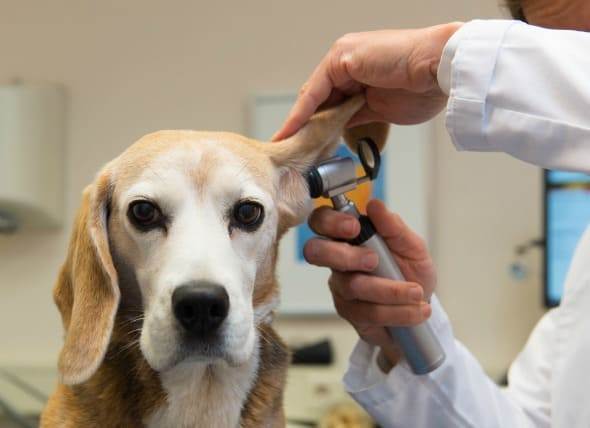
Dogs often are seen for tremoring or shivering. The patient can be any age or any size. Tremors can involve only certain muscles or body areas or the entire dog. Finding the reason behind tremors is tricky as tremoring occurs for many reasons.
First, think about normal reasons for shivering. Such as:
- cold
- frightened
- asleep and dreaming.
Usually these can be excluded from being a addressing the underlying cause shown above: providing a blanket or sweater, comforting the anxious patient, or rousing the sleeping patient.
Elderly dogs with muscle atrophy suffer from muscle fatigue and their muscles shake when over-worked. This is often pretty easy to distinguish as the patient is elderly and the tremors begin when the patient has been using their muscles longer than they would prefer. When muscle becomes tired, tremoring occurs and generally stops when the muscle is allowed to relax and the patient rests.
Mild shivers are rarely a significant symptom; it is the more violent involuntary tremors and twitches that indicate neuromuscular disease.
Only Certain Body Parts Tremor
If only certain body parts tremor, there are some neuromuscular diseases to consider.
Intention Tremors
Diseases involving the cerebellum of the brain will lead to tremors when the patient directs his attention to a task. The patient may sit quietly without tremors but if a bowl of food is put out, tremors of the neck and head erupt when the patient reaches for the food.
This sort of tremoring generally goes way beyond what might be described as shivering or even twitching. A classic example of cerebellar intention tremors is seen in kittens born with cerebellar hypoplasia, a neurologic condition stemming from the mother becoming infected with or vaccinated for feline distemper during pregnancy.
Cerebellar disease certainly does not have to be congenital. Any damage to the cerebellum (trauma, tumor, infection etc.) can produce an intention tremor, which is highly suggestive of cerebellar disease, and diagnostics should be pursued to find the underlying cause.
Idiopathic Head Tremors
No one really knows why this occurs but some dogs have episodes of head bobbing (usually up and down but can be side to side). Breeds that seem over-represented are Boxers, English bulldogs, beagles, and Doberman pinschers. This condition is totally unresponsive to seizure medications and the best way to curtail an episode seems to be to focus the dog’s attention on a toy or treat. Episodes tend to get milder with age. See this boxer’s head tremors.
Distemper Myoclonus
Dogs that survive a canine distemper infection may suffer from seizures, paralysis or muscle twitching long term. Often a young dog is adopted from the shelter or rescue and her history is unknown. Distemper myoclonus appears as involuntary twitches of muscle groups anywhere on the body. Multiple areas can be involved. These twitches are not seizures and do not respond to seizure medications. Numerous medications have been used with inconsistent results. The most successful treatment has involved injections of cosmetic Botox® into the muscle group involved, but this therapy is expensive and many dogs do not seem particularly inconvenienced by their myoclonus.
Whole Body Tremors
If the entire dog is shivering and shaking, then we must consider diseases that involve the entire dog. Normal muscles rely on oxygen, nutrients, and electrolytes from the bloodstream as well as normal electrical stimulation from the nervous system. We need to look at problems with these systems:
- Hypocalcemia (low blood calcium, especially if nursing puppies)
- Hypoglycemia (low blood sugar)
- Toxins (especially snail bait and insecticides)
- White Shaker Dog syndrome (which does not actually require that the dog be white), also called non-suppurative meningoencephalomyelitis.
- Seizures/epilepsy.
Severe tremoring can elevate the body temperature dangerously high and cause brain damage. Patients for which tremoring is an emergency are generally clearly mentally distressed by the involuntary motions or disoriented from the underlying neurologic disease.
Many toxins can cause twitches and involuntary muscle tremors, so it is important to let your veterinarian know what products are in your home. What flea products do you use? Do you have pesticides in the garden? These products are frequently neurotoxins that produce seizures and twitching. Snail baits containing metaldehyde are particularly common, as are permethrin-based flea products (generally safe for dogs but cats are uniquely sensitive). Tremors are a notable feature of chocolate toxicity. Obviously, poisoning is an emergency so you will need to see your veterinarian or local emergency service right away.
Brain diseases can produce seizures that can manifest as persistent but fine tremoring or more violent convulsions. Metabolic diseases, such as low blood sugar or low blood calcium, can lead to tremors and even seizures.
Muscle diseases such as tetanus can lead to involuntary muscle contraction. Twitches and tremors may be intermittent and are certainly not always emergencies; however, blood testing and possibly advanced neurology testing may be needed.
Your first step is going to be an evaluation with your veterinarian to narrow down the search and complete the necessary basic tests. Not all veterinarians are comfortable diagnosing neurologic disease, so discuss with your veterinarian whether referral to a specialist would be best for you and your pet. The best treatment plan can be made from there.


